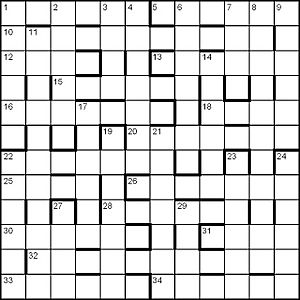Printer's Devilry facts for kids
A Printer's Devilry is a special kind of cryptic crossword puzzle. It was first created by a person named Afrit (whose real name was Alistair Ferguson Ritchie) in 1937.
Unlike regular crosswords, the clues in a Printer's Devilry puzzle don't directly describe the answer. Instead, each clue is a sentence. From this sentence, some letters have been taken out. Also, the punctuation and where the words break might have been changed. This makes a new sentence that still mostly makes sense.
Your job as the puzzle solver is to figure out what letters are missing. These missing letters will spell out a word or phrase. This word or phrase is what you need to write into the puzzle grid.
How Printer's Devilry Puzzles Work
Just like in a regular cryptic crossword, the clue's first meaning often has nothing to do with the answer. But a standard cryptic crossword clue usually has two parts: a wordplay part and a definition part. Printer's Devilry puzzles don't have either of these.
Let's look at an example to understand better:
A galling remark – an effective riposte is difficult (7)
—Azed, 1,888
The correct answer to this clue is INSTATE. If you put "INSTATE" back into the clue, it changes the sentence. It becomes: "Against a telling remark, an effective riposte is difficult".
To make this work, a space was removed between "a" and "galling". Two new spaces were added into "instate". Also, the dash was changed into a comma. It's like a printer made a mistake and you have to fix it!
Making Them Harder
A famous puzzle expert named Ximenes said that Printer's Devilry puzzles are usually easier than regular cryptic ones. But they can be made much harder. This happens when it's tricky to find where the letters were removed from the sentence.
A difficult Printer's Devilry clue might need big changes to the sentence. It's not just about adding the missing word. Here's an example of a tricky one:
"When he was dancing at the center, I could not see Jose like Tex," pens Esther. "'E were too high." (8)
—Bernard Lacy, New York Magazine volume 3 issue 4
The answer to this puzzle is MONASTIC. To make the sentence correct, you have to change it a lot. It becomes: "When he was dancing at the center, I could not see Jose Limon as ticket expenses there were too high."
Even with all these changes, the letters of the hidden word always appear in order. They also always appear together in one spot. The original sentence is only ever broken in one place to fit the answer.
Good Clues vs. Bad Clues
In Printer's Devilry clues, the original sentence might sound a bit strange or not make much sense. But the full sentence, once you add the answer, should always be logical and sound natural.
A common mistake when making these puzzles is to do the opposite. Some puzzle makers create a clue that sounds natural at first. But when you add the answer, the new sentence doesn't sound right. This makes it almost impossible to guess.
Ximenes, the puzzle expert, pointed out one such clue:
Do all the lines of travel cross in Galway? Slack supervision (6)
The answer to this clue is MORALE. When you put it in, the sentence becomes: "Do all the lines of tram or a level crossing always lack supervision?" Ximenes said this sentence was "so unnatural" that the clue would be "almost insoluble."
It's also considered bad puzzle design if the missing letters are taken from the very beginning or end of a word.


